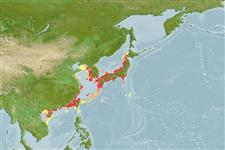Environment: milieu / climate zone / depth range / distribution range
Écologie
marin; profondeur 0 - ? m. Subtropical
Northwest Pacific: restricted to the temperate zone in coastal waters of continental China (from Peitaho in Liaotung Bay to Hong Kong), Taiwan, and Korea (Fusan).
Length at first maturity / Taille / Poids / Âge
Maturity: Lm ?, range 13 - ? cm
Max length : 16.1 cm SL mâle / non sexé; (Ref. 10943)
Description synthétique
Clés d'identification | Morphologie | Morphométrie
Épines dorsales (Total) : 0; Rayons mous dorsaux (Total) : 13 - 15; Épines anales: 0; Rayons mous anaux: 14 - 17; Vertèbres: 51 - 53. Long recurved unicuspid teeth arranged in only 1-2 rows in the anterior parts of both jaws. Predorsal scales 35-40; pelvic fins located closer to the origin of the pectoral fin so that the P2-C distance extended forward reaches the orbit. Lower jaw about equal to head length.
A coastal water species.
Life cycle and mating behavior
Maturities | Reproduction | Spawnings | Egg(s) | Fecundities | Larves
Collette, B.B. and J. Su, 1986. The halfbeaks (Pisces, Beloniformes, Hemiramphidae) of the Far East. Proc. Acad. Nat. Sci. Philadelphia 138(1):250-301. (Ref. 10943)
Statut dans la liste rouge de l'IUCN (Ref. 130435)
Menace pour l'homme
Harmless
Utilisations par l'homme
Outils
Articles particuliers
Télécharger en XML
Sources Internet
Estimates based on models
Phylogenetic diversity index (Ref.
82804): PD
50 = 0.5000 [Uniqueness, from 0.5 = low to 2.0 = high].
Bayesian length-weight: a=0.00257 (0.00115 - 0.00574), b=3.09 (2.91 - 3.27), in cm total length, based on LWR estimates for this Genus-body shape (Ref.
93245).
Niveau trophique (Ref.
69278): 3.0 ±0.4 se; based on size and trophs of closest relatives
Résilience (Ref.
120179): Haut, temps minimum de doublement de population inférieur à 15 mois (Preliminary K or Fecundity.).
Fishing Vulnerability (Ref.
59153): Low vulnerability (10 of 100).
